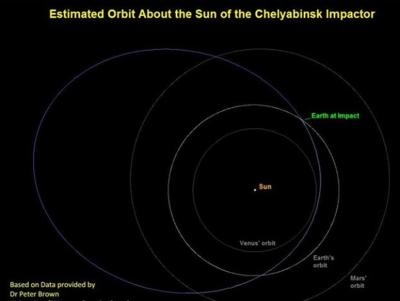Wed, Feb 20, 2013
Largest Such Event In More Than A Century
The first firm details of the meteor impact which occurred Friday in Russia, the largest in more than a century, are becoming clear. ESA is carefully assessing the information as crucial input for developing the Agency’s asteroid-hunting effort.

According to the ESA, at 0320 GMT on February 15, a natural object entered the atmosphere and disintegrated in the skies over Chelyabinsk, Russia. Extensive video records indicate a northeast to southwest path at a shallow angle of 20° above the horizontal. The entry speed is estimated at around 18 km/s, or more than 40,000 miles per hour. According to calculations by Peter Brown at the University of Western Ontario, Canada, drawing on extremely low-frequency sound waves detected by a global network, the object is estimated to have been about 55 feet across with a mass of about 10,000 tons when it entered the atmosphere. It exploded with a force of nearly 500 kilotons of TNT – some 30 times the energy released by the Hiroshima atomic bomb – at an altitude of under 65,000 feet.
With our current understanding of near-Earth objects, ESA says that events of this magnitude are expected once every several of tens to 100 years.
Detlef Koschny, who monitors near-Earth objects for ESA’s Space Situational Awareness (SSA) program, said that an the majority of the damage was caused by the airburst resulting in window breakage and some structural damage in downtown Chelaybinsk. Normally, some damage begins to occur at around five times normal air pressure at sea level. Widespread window damage is expected around 10–20 times this value. As the explosion and fireball progressed along a shallow trajectory, the cylindrical blast wave would have propagated directly to the ground and would have been intense.
Koschny said the terminal part of the explosion probably likely occurred almost directly over Chelyabinsk. This was perhaps the single greatest contributor to the blast damage. "We are waiting for confirmation from the Russian authorities that pieces of the object – bits of meteorite – have been found in the region," he said. "We’re unaware of any media reports of anyone or any structure being hit by any debris from the object itself."
(Graphic provided by ESA)
More News
The Industry Continues to be Rocked By Some Questionable Operations Recent investigations and a great deal of data has resulted in ANN’s SportPlane Resource Guide’s rep>[...]
Make Sure You NEVER Miss A New Story From Aero-News Network Do you ever feel like you never see posts from a certain person or page on Facebook or Instagram? Here’s how you c>[...]
Visual Approach Slope Indicator (VASI) An airport lighting facility providing vertical visual approach slope guidance to aircraft during approach to landing by radiating a directio>[...]
Airport Marking Aids Markings used on runway and taxiway surfaces to identify a specific runway, a runway threshold, a centerline, a hold line, etc. A runway should be marked in ac>[...]
Aero Linx: The Skyhawk Association The Skyhawk Association is a non-profit organization founded by former Skyhawk Pilots which is open to anyone with an affinity for the A-4 Skyhaw>[...]
 Unfortunate... ANN/SportPlane Resource Guide Adds To Cautionary Advisories
Unfortunate... ANN/SportPlane Resource Guide Adds To Cautionary Advisories ANN FAQ: Turn On Post Notifications
ANN FAQ: Turn On Post Notifications ANN's Daily Aero-Term (04.29.24): Visual Approach Slope Indicator (VASI)
ANN's Daily Aero-Term (04.29.24): Visual Approach Slope Indicator (VASI) ANN's Daily Aero-Term (04.28.24): Airport Marking Aids
ANN's Daily Aero-Term (04.28.24): Airport Marking Aids ANN's Daily Aero-Linx (04.28.24)
ANN's Daily Aero-Linx (04.28.24)



